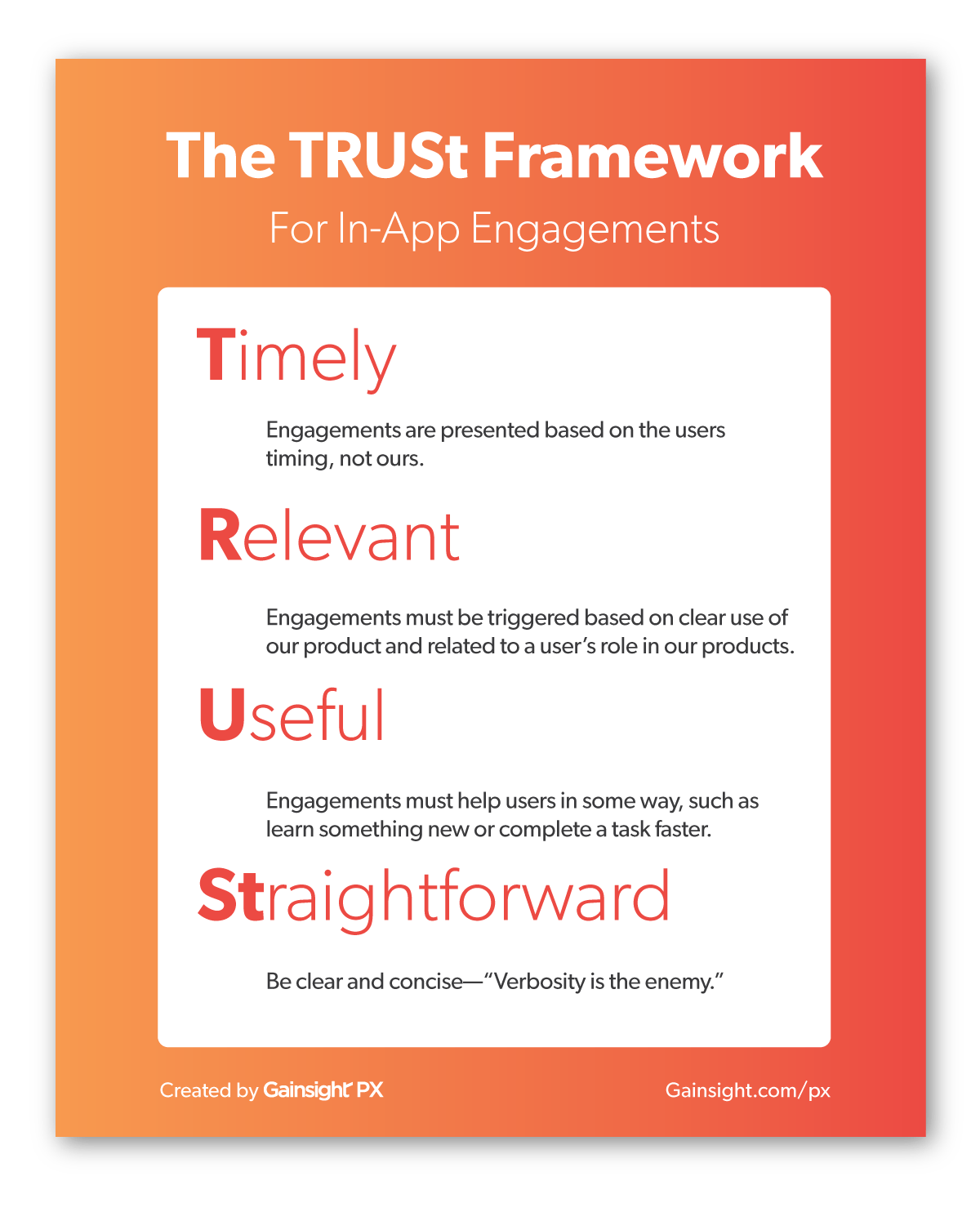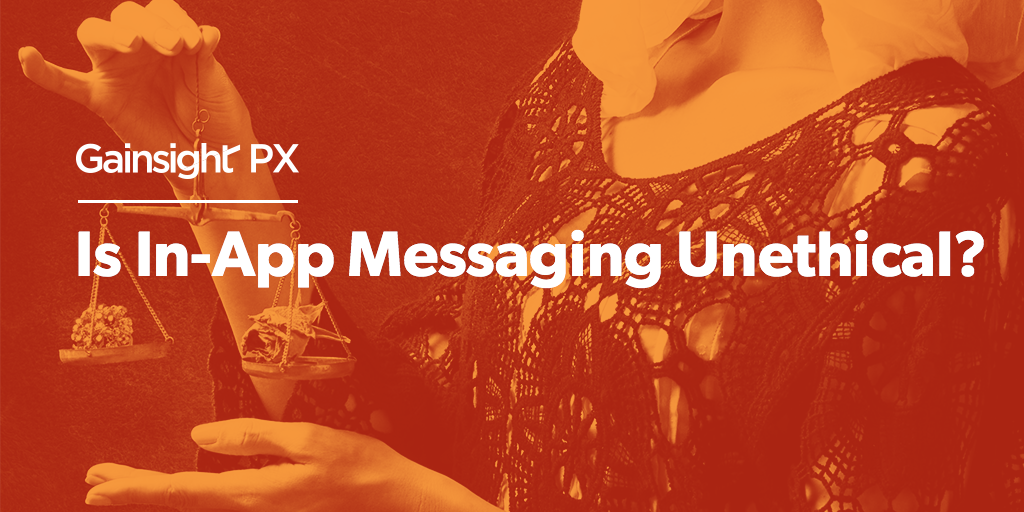Guess what? You can talk to your users in-product without sacrificing the customer experience.
Like a broken record, you’ve probably heard over and over that the business world is changing. Subscriptions have overtaken traditional models. Customers have more options, therefore more power. The way we run business requires new functions and new tools. As we adjust to these new definitions of business, we encounter an attitude that commonly occurs when people are exposed to new things: fear.

No, I’m not talking about the exaggerated horror-movie fear—I’m talking about the more insidious kind of fear that results in hesitancy and slows growth. In-app communications are part of the next wave of adoption-driving strategies and I’m here to assure you that they are not as scary as they sound. They will benefit your company, as long as you do them the right way.
The Evolution of Customer Communications
In the beginning, there were door-to-door salespeople. People appreciated face-to-face interactions and businesses were quick to realize that this was necessary to build trust.

This didn’t end with the decline of door-to-door sales. Even in SaaS, most organizations prided themselves on providing exemplary customer support and account management. So much so, that the preferred customer communication vehicle was an in-person meeting. This level of customer engagement is awesome, however, it’s also quite costly.
It requires higher-qualified account teams who are domain experts for each individual customer. And consider the opportunity costs. With a high-touch customer engagement model, your customers are at the mercy of your communications. Their adoption of your products is limited by your ability to get information to them at scale. This model limits who is aware of new capabilities because more often than not, communication is gated by your customer’s primary stakeholder.
The Rise of Communication at Scale
To address this challenge, the business world introduced email communications. Using technologies like Marketing Automation and Gainsight’s Journey Orchestrator, we were suddenly able to increase the reach and frequency of customer communications.
For many organizations, automation provides a great vehicle to communicate personalized interactions with your customers without greatly increasing costs. But, as the volume of emails your customers receive increases, the effectiveness of this communication vehicle declines. In 2018, over 281.1 billion emails were sent daily and the number is projected to increase to reach 347.3 in 2023. Suffice it to say, it’s getting easier to get lost in the noise and email is becoming a less dependable vehicle for critical customer communications.
The Next Age of Communicaton: In-App Engagements
With the advances in product technology, businesses can now use their products as a vehicle to communicate with their customer. There are tremendous advantages in using your product as a customer communication channel. You can create personalized messages with ultra-relevance to a user’s app activity, job title, role—or all three. In a survey taken in 2017, 63 percent of respondents saw increased conversion rates as the main benefit of in-app personalization.
In-app engagements get you one step closer to your users and, when done with precision, can even enhance the product experience.
Calming the In-App Communication Anxiety
This new age of communication is not all rainbows and sunshine. As I said before, with anything new, there is often an associated fear. In the case of using your product as a communication channel, the fear is over-communicating (a.k.a. spamming) your users. The fear commonly arises when you think about how non-product teams may abuse this new channel.
One of the major differences between in-app and other communication channels is that in-app has an organizational owner. Product teams have typically owned the user experience. They’re in control of what a user sees and how they interact with the product. With advances in technology, now other non-technical teams can use products to interact with the end user, independent of the Product team’s strategy.
It’s common for companies who create enterprise software to hear the objection: “Our customer pay us a lot of money and they are logging into the product to complete a given task. They don’t want to be interrupted by a non-critical that is unrelated to the task at hand.”
This statement is coming from a good place and is often influenced by how other channels—like email—have been abused. And guess what? They’re not entirely wrong. I bet everyone reading this can quickly name one or two of the loudest voices in their inbox, or an experience where they felt like their workflow was interrupted by a poorly-timed pop-up.
The In-App Engagement TRUSt Framework
So, how does one get the advantages of in-app engagements without sacrificing the customer experience?
The key to effective communication, regardless of channel, is simple: every engagement must provide value to the recipient. To do this, you and your team must shift your mindset and put the user’s goals before your organizations.
At Gainsight, we introduced the TRUSt framework to help evaluate which customer communications should be delivered in-app or through conversation.
Timely:
Engagements are presented based on the user’s timing, not ours. Introducing in-app guides for advanced functionality on a user’s first login is too early. Presenting an in-app survey six months after the user completed a task is too late.
Relevant:
Engagements must be triggered based on clear use of our product (or lack of use within a reasonable amount of time) and related to a user’s role in our products.
Useful:
Engagements must help users in some way, such as learn something new or complete a task faster.
Straightforward:
Be clear and concise—“Verbosity is the enemy.”

This framework works to avoid communication fatigue and add to the product experience, not detract.
Getting Started with In-App Engagements
Engaging with your customers while they’re in your product is helpful for them and your business. It can be easy to snap to the decision that marketing to your customers is unethical, but this is only if it’s done in that way. Understand the mistakes that lead to bad experiences so you can work to avoid them within your own instances and increase adoption at scale.
We’ve created an In-App Engagement Starter Kit with guidelines and frameworks to help you set up your in-app engagement strategy.
After you’ve read our In-App Engagement Starter Kit, you’ll start to really notice the in-app engagements that pop-up in your day-to-day. What makes them relevant or not? Did they miss the mark? How can you avoid that sort of dissonance in your own engagements? What would’ve been better timing or messaging?
Take these observations and create your own ethical in-app engagement strategy using Gainsight PX today.

